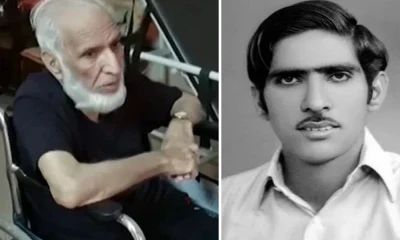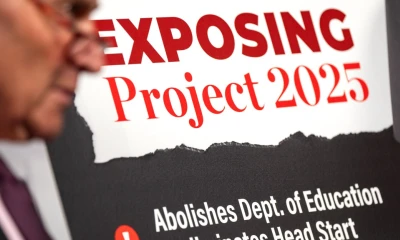Regional
Romantic norms are in flux. No wonder everyone’s obsessed with polyamory.
Why everyone’s talking about polyamory and Molly Roden Winter’s memoir More.

Everyone’s talking about polyamory. You might have read about it, at least if you pay attention to the New York Times, the Wall Street Journal, the New Yorker, the Washington Post, the Atlantic, or New York magazine, or if you listen to podcasts like Esther Perel’s Where Should We Begin? and The Ezra Klein Show. Maybe you’ve seen versions of polyamory plots on TV, like Succession’s Shiv Roy and Tom Wambsgans’s shaky open marriage or the Riverdale finale’s reveal that its four main characters spend their senior year in a quad. Perhaps you’ve noticed that, in many of these cases, the news peg is the release of Molly Roden Winter’s new memoir, More, an account of the writer’s 10 years in an open marriage.
Why this one account of polyamory — the practice of having consensual romantic or sexual relationships with multiple people — went so viral is anyone’s guess: It’s not as if people haven’t written memoirs about nonmonogamy before, and the reviews so far have been mixed. While many praise her perspective as a mother pushing back against stereotypes about who gets to have the sex they want and who doesn’t, much of the criticism has revolved around Winter’s privilege, some of which feels fair (that she seemed to lack empathy for the younger, less wealthy secondary partners involved in her marriage) and some less so (the fact that she’s a homeowner in a fancy part of America’s biggest city is obviously a main reason major media outlets are talking about her book, but it’s not as if she’s claiming a universal experience).
Yet the current discursive fever pitch on polyamory isn’t just about Winter’s memoir. It’s also not just about polyamory, a practice that has existed for millennia, though mainstream interest in it has spiked from time to time. Christopher Gleason, historian and author of the new book American Poly, explains that in the ’80s and ’90s, poly activists attempted to destigmatize the practice by contextualizing it within Reagan-era moral standards. But this moment, he says, feels bigger than any we’ve had so far: “Americans in general, we’re rethinking intimate relationships on a much deeper level.”
Consider the data: There’s currently a record-high share of 40-year-old Americans who’ve never been married (25 percent, as of 2021, an increase from 20 percent in 2010 and 6 percent in 1980), and according to a Pew Center study last year, only 23 percent of Americans see marriage as essential for living a fulfilling life. More than half of single Americans say they aren’t looking for a relationship or even casual dates, largely because they enjoy singlehood or have more pressing priorities. The birthrate has been steadily falling since the Great Recession, which the Brookings Institution argues stems from “shifting priorities” rather than political or economic changes. Young people are having sex later; from 1991 to 2015, a CDC survey found that the percentage of high schoolers who’d had intercourse dropped from 54 percent to 41 percent. The reasons people are having less sex, according to the viral “sex recession” Atlantic feature from 2018, range from smartphone access to surveillance culture, gamified online dating, and improved awareness of boundaries and gender politics. In other words, it’s likely a variety of cultural shifts that explain these changes rather than a single silver bullet.
Americans’ attitudes toward monogamy have evolved in tandem: More than one in five single folks have engaged in some form of consensual nonmonogamy, nearly one-third of people in monogamous relationships say their favorite sexual fantasy involves some kind of open relationship, and 51 percent of adults under 30 say that open marriages are acceptable. Openly queer people, who tend to be more likely to approve of different forms of polyamory, now make up a larger percentage of the population, with 17 percent of adults under 30 identifying as lesbian, gay, or bisexual. Anyone who’s used a dating app has likely confronted the choice to list oneself as “ethically nonmonogamous,” and with the mainstreaming of apps like Feeld, which are specifically geared toward kink, threesomes, and other forms of polyamory, these terms are now part of everyday relationship discourse.
The pandemic also may have accelerated this: Around 2021, explains Leanne Yau, polyamory educator and founder of the blog Poly Philia, “People came out of a very profound period of isolation, and it led to a lot of people reconsidering the decisions they made and perhaps wanting to explore something different.”
In response, the pro-marriage cohort is getting louder. They cite studies that show married people are happier and wealthier, and are more likely to raise happy children. New York Times columnist David Brooks last year advised young people to “obsess less about your career and to think a lot more about marriage.” Economist Melissa Kearney’s recent book argues that the falling marriage rate is to blame for rising inequality. In the face of greater political polarization between the sexes (young women are increasingly likely to be liberal, young men conservative), a recent Washington Post op-ed suggested that “someone will need to compromise” if they ever hope to marry. (Left unasked was why, say, a woman in a post-Roe world would ever want to date someone who did not think she deserved autonomy over her own body.) Loudest among them is University of Virginia sociologist Brad Wilcox’s book Get Married: Why Americans Must Defy the Elites, Forge Strong Families, and Save Civilization, which claims that liberal thought leaders’ denial of the importance of marriage amounts to “an unusual form of hypocrisy that, however well intended, contributes to American inequality, increases misery, and borders on the immoral.”
And those are just the fancy people with book deals and newspaper columns. All over the internet, regular folks are freaking out about marriage, sexuality, and gender, too: You’ve likely heard of tradwives, or women who make public performances of their adherence to old-fashioned gender norms — some of whom do so while selling overpriced cookware and downplaying their connections to billionaires. Maybe you’ve seen men proudly claim to eschew masturbation because they believe that semen retention holds the key to one’s true masculine energy. (Heard of the Liver King? If not, don’t Google it.) One of the most popular influencers among teenage boys is a proud misogynist who speaks frequently about his disrespect for women’s autonomy (and is currently awaiting trial on charges of rape and human trafficking). Conservative talking heads moan about “blue hair and pronouns” while TikTok “experts” encourage women to date exclusively for money in a kind of depressing, warped version of feminism where the only thing a man might have to offer a woman is financial security and designer purses.
All of these phenomena are responses to changing sexual norms and declining marriage rates. As is, I’d argue, the reason why polyamory is striking such a chord right now: People panic when they’ve been confronted with their own freedom. “It can be very comforting to go on a set path: be exclusive, get married, and have kids,” explains Yau. “Knowing that there are options outside of that can be a really terrifying prospect for people who might never have questioned this kind of thing in their lives.”
It is, naturally, quite difficult to have frank discussions about marriage and monogamy. There are feelings and money and families involved, and the idea of infidelity in particular is uncomfortable and emotional for many. “A lot of people have trauma around that, and seeing people enthusiastically embrace having [multiple partners] and openly practicing something they see as a betrayal of trust is a fundamentally destabilizing experience for them, even though the point of polyamory is that everyone is open and consenting,” says Yau.
“I think [people] are really nervous that it’s contagious,” adds Jessica Fern, author of two popular books about navigating attachment and nonmonogamy, Polysecure and Polywise. “There’s a real fear, that, ‘If my husband hears that this is an option, he’s gonna want it, and I don’t necessarily want to do that.’” A big portion of society will also tend to view polyamory as something exclusively beneficial to men, which Gleason points out misunderstands polyamory’s roots in American culture. Sexual freedom has always been the end goal for the feminist and queer liberation movements, without which polyamory wouldn’t be a point of discussion at all.
For single straight women, it can often feel as though the number of men listing themselves as ethically nonmonogamous on dating apps is an indication that they, as one woman described to Vogue, “use non-monogamy to convey a sense that they are so free-spirited that they simply cannot be pinned down,” as a means to avoid any emotional responsibility in relationships. Dating apps, according to pretty much everyone, are “in their flop era,” overrun with bots and sneaky paid features designed to get you to fork over money to connect with anyone you’d actually want to date. “There’s a much bigger swath of the population that is experiencing their lives as single, and not just as a ‘phase’ in your 20s. Your long-term reality is a succession of relationships or short-term arrangements, and I think that percentage is probably going to grow,” says Emily Witt, author of Future Sex: A New Kind of Free Love.
With more people marrying later and fewer people marrying at all, many of us will be rethinking how we organize our lives. That can be a hugely positive exercise: In The Other Significant Others: Reimagining Life With Friendship at the Center, NPR’s Rhaina Cohen makes the case for handling questions of child care, elder care, and living arrangements not with marriage as the de facto support system but strong platonic relationships. Polyamorists have also contributed to this reimagining: We live in a world “built for the couple,” per Fern, but what would it look like when parental rights, estate planning, or even architecture (why should a house only have one primary bedroom, for instance?) were built for more than just two people in a romantic relationship?
“There’s been this deconstruction wave for the last few decades,” says Fern. “Straightness was deconstructed, and then gender’s been deconstructed. And now it’s monogamy’s turn.” While the prospect of a life outside monogamy and marriage might threaten people’s images of the lives they imagined they’d have, it could also allow people the freedom to create something potentially even more meaningful.
“We all get really exhausted with internet dating, but I think it’s good to remind ourselves how amazing it is,” says Witt. “You can go have a drink with somebody, and even if they’re not the love of your life, at least you’re meeting people. You’re not doing this on your own, you’re not some social outcast, and there’s like a lot of other people in the same boat.” If the discourse around polyamory is encouraging people to be more honest about their desires, to examine their lives more clearly, and communicate more directly with their current and potential partners, and to question the value of societal expectations, then that feels like a win — even if you don’t have any interest in participating.
This column was first published in the Vox Culture newsletter. Sign up here so you don’t miss the next one, plus get newsletter exclusives.
-

 Pakistan 2 days ago
Pakistan 2 days agoGrace marks increased from 3 to 5 in exams
-

 Pakistan 2 days ago
Pakistan 2 days agoWarrior-VIII: Pak-China joint anti-terrorism exercise kicks off
-

 Pakistan 1 day ago
Pakistan 1 day agoInternet, mobile services to be partially suspended in Islamabad, KP, Punjab
-

 Business 1 day ago
Business 1 day agoBitcoin breaks $96,000 for first time as market weighs over Trump crypto plans
-

 Sports 2 days ago
Sports 2 days agoPakistan U-19 beat Afghanistan by 13 runs in Tri-nation series
-

 Sports 2 days ago
Sports 2 days agoPunjab announces e-bikes for every student
-

 Sports 1 day ago
Sports 1 day agoFormer cricketer, umpire Nazir Jr. passes away
-

 Pakistan 2 days ago
Pakistan 2 days agoPTI founder secures bail in Toshakhana II case
































